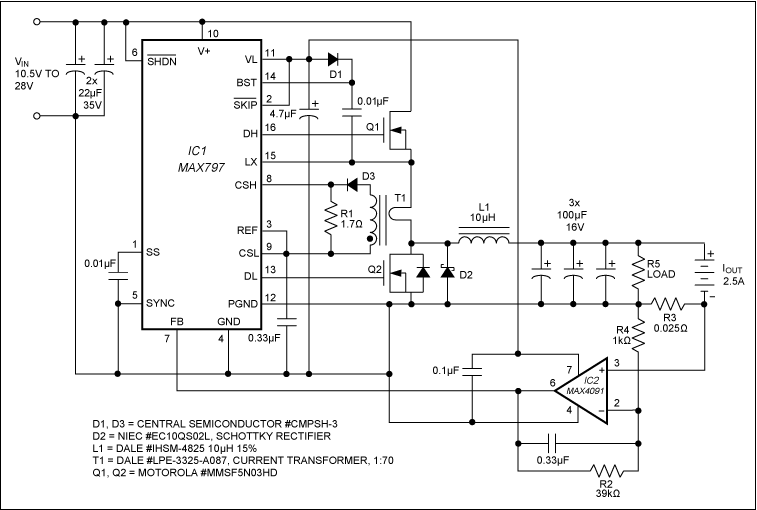Abstract
This design note shows how a circuit with modified feedback paths transforms a switch-mode power supply into a highly efficient battery charger. The battery charger is based on a step-down controller, the MAX797, and charges up to six cells with > 96% efficiency at higher output voltages.
A related idea appeared in the October 12, 1995 issue of EDN.
Battery chargers are usually designed without regard for efficiency, but the heat generated by low-efficiency chargers can present a problem. For those applications, the charger of Figure 1 delivers 2.5A with efficiency as high as 96%. It can charge a battery of one to six cells while operating from a car battery.

Figure 1. Modified feedback paths transform this switchmode power-supply circuit for notebook computers into a high-efficiency battery charger.
IC1 is a buck-mode switching regulator that controls the external power switch, Q1, and the synchronous rectifier, Q2. These n-channel MOSFETs are more efficient than equivalent p-channel types because their on-resistance is lower; therefore they drop less voltage when conducting a given amount of current. IC1 includes a charge pump for generating the positive gate-drive voltage required by Q1.
The battery-charging current develops a voltage across the 25mΩ resistor R3 that is amplified by the op amp and presented as positive-voltage feedback to IC1. This feedback enables the chip to maintain the charging current at 2.5A. While charging, the circuit can also supply current to a separate load, up to a limit set by the current-sense transformer, T1, and sense resistor, R1.
T1 improves efficiency by lowering power dissipation in R1. The transformer turns ratio (1:70) routes only 1/70 of the total battery-plus-load current through R1, creating a feedback voltage that enables IC1 to limit the overall current to a level compatible with the external components.
Efficiency exceeds 96% at the higher output voltages (Figure 2). (Lower output voltage produces less output power, so the relatively fixed amount of dissipation associated with Q1, Q2, and IC1 represents a larger percentage of the total.) If you inadvertently disconnect the battery during a charge, VOUT cannot rise to a dangerous level (as it can in a boost-mode topology) because the charger's buck-mode topology limits the maximum output voltage to VIN.

Figure 2. Efficiency for the Figure 1 battery charger rises with output voltage.
Related to this Article
Products
Step-Down Controllers with Synchronous Rectifier for CPU Power
Single/Dual/Quad, Micropower, Single-Supply, Rail-to-Rail Op Amps
Product Categories
{{modalTitle}}
{{modalDescription}}
{{dropdownTitle}}
- {{defaultSelectedText}} {{#each projectNames}}
- {{name}} {{/each}} {{#if newProjectText}}
-
{{newProjectText}}
{{/if}}
{{newProjectTitle}}
{{projectNameErrorText}}




















